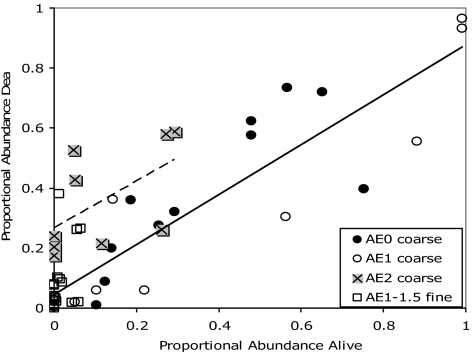Fig. 3.
The proportional abundances of grass-dwelling mollusks in death assemblages are, in general, positively correlated with those in the local living communities, based on analysis of 47 large coarse-mesh data sets from 16 lagoons in the Gulf of Mexico (scatterplot of raw data). In the 11 lagoons with negligible (AE0, black circles) to mild AE (AE1, open circles), grass-dwellers constitute up to 100% of individuals in the living community, which is closely reflected by death assemblages (solid trendline for raw data; linear regression of arcsin-normalized proportions r2 = 0.81, P ≪ 0.001, slope = 0.83, y-intercept = 0.01 after back-transformation). In the five lagoons where anthropogenic eutrophication is severe, grass-dwellers are absent to sparse in the living assemblage and are enriched in the death assemblage, usually by ≥20% (AE2 asterisks with gray shadow, 9 data sets; dashed trendline is for raw AE2 data; for normalized data, r2 = 0.39, P = 0.07, slope = 0.83, y-intercept = 0.23 after back-transformation). Fine-mesh data sets from the Gulf of Mexico region are all from northern Texas lagoons, where grasses are commonly suppressed by freshwater runoff and where AE is long-standing (11 data sets from two AE1 lagoons, 5 data sets from two AE1.5 lagoons; open squares). Grass-dwellers occur in only trace abundance in both living and death assemblages there, with the exception of death assemblages from three marginal sands that are enriched in grass-dwellers and are reasonable past habitats for seagrass.

